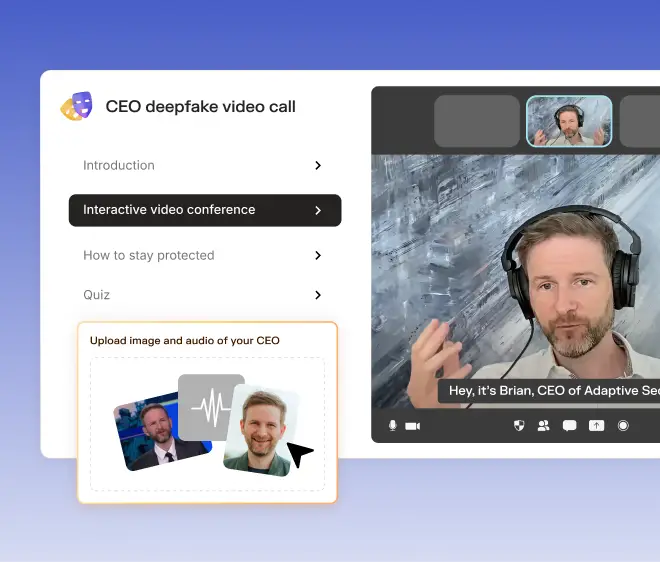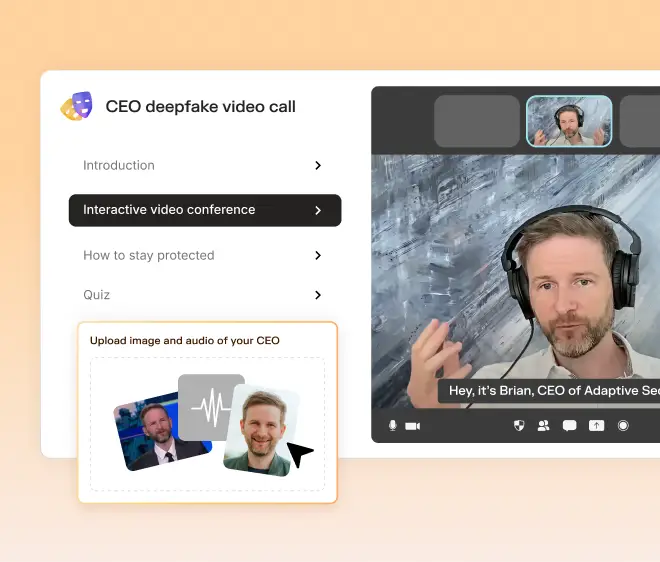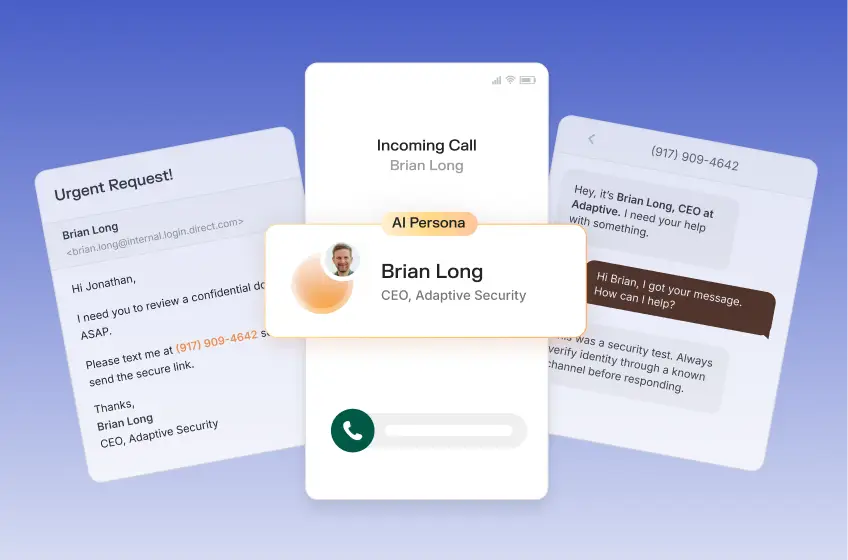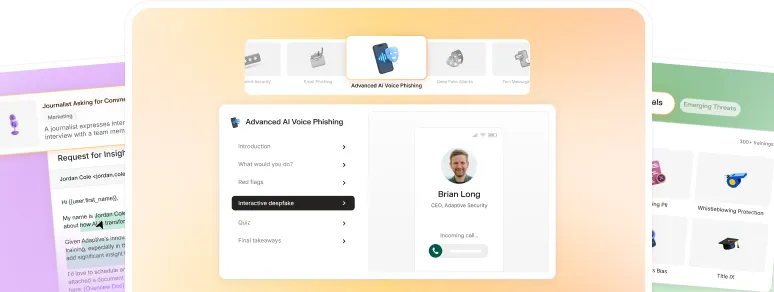In 2025, the greatest threat to an organization’s security posture isn’t a flaw in any software.
AI-powered social engineering has emerged as a top risk for businesses, weaponizing psychology at an unprecedented scale and sophistication. Attackers have evolved far beyond the typo-ridden emails of the past, leveraging artificial intelligence to create perfectly crafted, multi-channel deception campaigns that are nearly indistinguishable from legitimate communications.
Social engineering is the age-old art of psychological manipulation, and today it’s supercharged by AI. Cybercriminals are carrying out devastating deepfake scams and other advanced threats that bypass even the most robust technical defenses.
As numerous cybersecurity experts note, social engineering risks are present, they’re evolving, and the costs of a data breach are increasing.
Take advantage of this playbook as the definitive guide to navigating a new reality, delivering actionable strategies that can be implemented immediately to harden defenses.
Social Engineering Risk Landscape
Building a resilient defense starts with understanding today’s battlefield. The data paints a clear and urgent picture: Social engineering is a dominant attack vector, and its complexity is growing rapidly.
Attackers are successfully exploiting the innate human tendency to trust, and they’re doing it with extreme technological leverage.
- The Human Element Dominates: According to the 2025 Verizon Data Breach Investigations Report (DBIR), the human element remains a significant factor in the vast majority of breaches, currently sitting at 60%. It proves that attackers find it far more efficient to manipulate a person than to break through complex endpoint security, making an organization’s employees their primary target.
- AI as a Force Multiplier: Research from IBM X-Force reveals that generative AI helps an attacker craft a convincing, personalized phishing email in just five minutes. Previously, this task required a skilled human team around 16 hours, underscoring a significant leap in efficiency that enables cybercriminals to launch highly targeted campaigns at scale.
- Financial Impact Soars: Losses from cybercrime exceeded $16 billion in 2024, according to the FBI’s Internet Crime Complaint Center (IC3). Phishing wasn’t just a cause for this 33% increase; it was the single most reported crime type.
- Omnichannel Attacks are the New Norm: Attackers no longer rely on a single channel. Instead, they orchestrate campaigns across multiple channels simultaneously. Imagine a fraudulent request that begins with an email, is reinforced by a convincing text message, and is finalized with a deepfake voice call from a cloned colleague.
The strategic layering of multi-channel communication makes every type of phishing attack more believable and harder for untrained employees to detect, proving that single-channel training is no longer enough.
How AI and deepfakes change the threat model
Generative AI has democratized sophisticated cybercrime, putting nation-state-level weapons into the hands of common criminals.
Deepfakes, synthetic media where a person’s likeness or voice is convincingly replaced with an AI-generated substitute, are an example of this terrifying evolution. Neither grainy nor robotic, these attacks are seamless, persuasive, and incredibly dangerous.
Consider the following real-world scenarios that have already occurred:
- Deepfake Video Conference: In 2024, a finance employee at Arup, a multinational engineering firm, was deceived into transferring $25 million. The employee participated in a video conference with individuals they believed to be the company’s chief financial officer (CFO) and other senior executives. In reality, every person, apart from the victim, was an AI-generated deepfake replica.
- AI-Generated Recruiter on LinkedIn: Attackers are creating hyper-realistic yet entirely fake LinkedIn profiles for corporate recruiters, utilizing AI to generate professional headshots, craft compelling job descriptions, and automate outreach. Building rapport with targets over several days or weeks, they send a fake job offer that contains a malicious link designed to steal credentials or deploy ransomware.
Both examples highlight how AI enables attackers to achieve unprecedented speed, scale, and personalization, making it easier for them to bypass traditional security awareness training.
Biggest human attack surfaces in 2025
Employees are an organization’s strongest defense layer, but their collective digital footprint is also the largest and most vulnerable attack surface.
Attackers are laser-focused on exploiting everyday platforms and services that teams use to communicate, collaborate, and accomplish their work.
- Corporate Communication Channels: Email remains the number one attack vector, but it’s now part of a larger ecosystem of risk. SMS text messaging, phone systems, and collaborative platforms like Zoom and Microsoft Teams are all being actively targeted.
- Public Exposure Vectors: Information gleaned from employee social media profiles (like LinkedIn), corporate websites, and press releases provides the raw material for highly personalized and believable phishing lures.
- Hybrid and Remote Work Vulnerabilities: The line between personal and professional life has blurred, and employees using personal devices for work or connecting via unsecured home and public WiFi networks create new, often unmonitored, entry points for attackers to exploit.
Each of the touchpoints represents a potential open door into an organization, and attackers are constantly probing them for the path of least resistance.
Regulatory pressure and insurance requirements
A growing web of global regulations and stringent insurance requirements is forcing organizations to treat human risk with the seriousness it’s long deserved.
- Stricter Mandates: Rules like the SEC’s rule on incident disclosure, which requires public companies to report material cyber incidents within four days, and the EU’s NIS2 Directive, which explicitly mandates ongoing cybersecurity training for all employees, have raised the stakes for compliance.
- Cyber Insurance Scrutiny: Obtaining or renewing a cyber insurance policy in 2025 is an intensive process. Insurers now issue detailed questionnaires demanding concrete proof of a robust security program, and they’re no longer satisfied with a check-the-box annual training certificate.
Failure to meet today’s standards could result in denied claims, soaring premiums, or the inability to secure coverage at all, making proactive security awareness training a necessity.
Security Awareness Training & Phishing Simulation Playbook
Any effective defense is built on a proactive framework that combines a resilient culture, realistic technology, and a well-defined process.
Here’s the playbook providing the steps to build that framework.
Building a security-first culture
Technology alone will always be insufficient. CISOs and their teams must foster an environment where employees feel both empowered and responsible for the organization’s security, transforming the workforce from a liability to an asset.
- Leadership Sponsorship: A strong security culture starts at the top. When executives visibly champion and participate in security initiatives, it sends a powerful message that security is a core business value rather than only an IT matter.
- Psychological Safety: Create a ‘no blame’ reporting culture. Employees need to feel safe reporting a suspected phishing attempt or even admitting they clicked a link, without any fear of punishment. It transforms a potential mistake into real-time threat intelligence.
- Continuous Engagement: Annual training is forgettable and ineffective. Instead, use a continuous cycle of microlearning, gamification, and positive reinforcement to keep security top-of–mind year-round.
- Security Champions: Identify enthusiastic employees in different departments to act as security champions, peer coaches who answer colleagues’ questions, promote best practices, and serve as a trusted, grassroots extension of the official security team.
Embedding these principles into an organization shifts security from a passive requirement to an active, collective responsibility.
Designing multi-channel simulation scenarios
Phishing simulations must reflect the complex, multi-channel threats employees actually face. A generic email blast won’t cut it.
Follow this three-step process for maximum effectiveness:
- Reconnaissance: Begin by analyzing the organization’s specific risks. Consult with the security operations team to understand what real-world attacks actually look like. What departments or roles are targeted most often? What pretexts are commonly used? Use this internal threat intelligence to inform campaign design.
- Campaign Design: Create realistic, multi-channel simulations that test employees across the full spectrum of attack vectors, including email, voice, video, SMS, and beyond.
- Analysis: Go beyond click rates. Track who clicks, who reports, and how long it takes employees to report. Use this rich data to identify knowledge gaps and high-risk departments, which allows IT and security teams to refine and target the next wave of simulations.
Tailor the difficulty of phishing simulations based on role and department, sending the most sophisticated lures to high-value targets like finance, HR, and IT.
Response and reporting workflow
When an employee spots a threat, the reporting process should be frictionless and trigger an immediate, automated defensive action. A slow or complicated reporting process discourages participation, giving attackers more time to succeed.
- Immediate Self-Report: Employees must be able to report a suspicious message with a single click, either via an integrated button in their email client or a dedicated keyboard hotkey.
- Automated Response: In a single click, an automated workflow is triggered. The action should instantly create a ticket in the organization’s security platform, quarantine the threat from all other employees to prevent further spread, and share the threat intelligence with the incident response (IR) team.
- Analysis & Feedback Loop: The security team performs a root-cause analysis on the reported threat, and key insights then inform the design of the next phishing simulation campaign, creating a continuous loop of improvement.
The streamlined process accelerates response time while also reinforcing positive behavior by demonstrating to employees that their actions have an immediate and tangible impact on the organization's security.
KPIs That Prove Risk Reduction
Justify the budget, secure executive buy-in, and demonstrate progress by tracking metrics that matter with security KPIs that move past outdated completion rates to prove measurable risk reduction.
Detection and reporting rate
Measure the percentage of simulation recipients who correctly identify and report a phishing attempt within a set timeframe. A low click rate is good, but a high reporting rate is great. It signifies an active and engaged workforce that serves as a human firewall.
Here are benchmark tiers to understand:
- Beginner: <205 reporting rate
- Intermediate: 20% to 45% reporting rate
- Mature: >70% reporting rate
The tiers provide a clear roadmap for progress and help set realistic, incremental goals for a security awareness training program.
Mean time to report (MTTR)
Measure the average time, in minutes or hours, from when a phishing email is delivered to when the first employee reports it. Reducing this time is critical because it shrinks the attacker’s window of opportunity to pivot, steal data, or deploy malware.
A fast mean time to report can be the difference between a minor incident and a major data breach, so a strong organizational goal is to cut MTTR by 30% year-over-year.
Board-level risk score and ROI
Translate human-factor metrics into the language of the boardroom: financial risk and return on investment (ROI). By pairing phishing simulation outcomes with industry-standard incident cost models, organizations build a powerful narrative that demonstrates tangible value.
Below is an example of KPI improvements and potential financial impact:
Presenting data in this format shifts the conversation about security awareness training from a cost center to a strategic investment in risk mitigation.
Choosing a Security Partner
Selecting the best platform for security awareness training and phishing simulations is one of the most important decisions to make. The market is crowded, but a structured evaluation process helps find a partner that meets an organization’s needs.
Evaluation criteria for a platform
Use a weighted scorecard to conduct an informed comparison of potential partners.
Score each vendor on a scale of 1-5 across the following criteria:
- Content Realism & Variety: Does the platform support a wide range of multi-channel phishing simulations that reflect real-world threats?
- AI-Powered Customization: Can the platform utilize AI to generate content tailored to emerging threats, regional trends, and specific employee roles?
- Analytics & KPIs: Is the analytics dashboard intuitive? Does it provide granular, board-ready metrics that clearly demonstrate program effectiveness and ROI?
- Integration Ease: How easily does the platform integrate with an existing security stack?
- Regulatory Alignment: Does the platform provide templates and reporting features to help generate compliance evidence for mandates like NIS2, DORA, and SEC rules?
- Support Quality: What level of technical and strategic support is offered during implementation and for ongoing operations?
- Total Cost of Ownership: What is the full, transparent cost, including licensing, setup fees, and any optional maintenance or support packages?
A thorough evaluation using these criteria ensures IT and security teams choose a long-term partner, not a short-term vendor.
Adaptive Security’s capabilities
Adaptive Security is designed from the ground up for the always-changing threat landscape, with a next-generation platform that directly addresses the critical evaluation criteria needed to build and manage a resilient human firewall in 2025 and beyond.
- AI Training & Simulations: A vast, fully customizable library of multi-channel content mirroring the latest real-world threats, ensuring employees are prepared today for what’s coming tomorrow.
- Granular KPIs Dashboard: Deep insights into user behavior go beyond click rates, providing deep insights into reporting behavior and overall risk with board-ready reports.
- Regulatory Readiness: Demonstrate compliance with global regulations, saving the organization hundreds of hours in audit preparation and avoiding potential fines.
As a partner trusted by leading global brands, Adaptive Security provides the tools, intelligence, and support necessary to turn a training program into a cornerstone of a cybersecurity strategy.
From Playbook to Practice
The threat of social engineering has never been greater, but a structured, data-driven approach significantly hardens an organization’s defenses against it. Building a robust security culture, deploying realistic multi-channel phishing simulations, and tracking the right KPIs are the essential pillars of a successful security program.
When choosing a partner, it’s vital to align platform features with the organization’s specific risks and strategic priorities to ensure an investment in more than just a solution.
Ready to put this playbook into practice? Discover how Adaptive Security helps build and measure a security program that stands up to the threats of 2025 and beyond.




We are a team of passionate technologists. Adaptive is building a platform that’s tailor-made for helping every company embrace this new era of technology without compromising on security.
Contents



Want to download an asset from our site?





.avif)
.avif)



